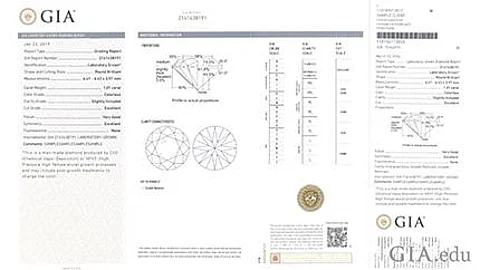

Following the recent update to the Federal Trade Commission (FTC) Jewelry Guides, GIA has revised its education materials supporting its core consumer protection mission and updated its grading reports for laboratory-grown diamonds to align with the revised guides. Beginning July 1, 2019, GIA Laboratory-Grown Diamond ReportsTM and identification reports will no longer use the term ‘synthetic.’
The new GIA Laboratory-Grown Diamond Report will feature the same visual representation of the scales for color, clarity and cut as GIA’s grading reports for natural diamonds. The updated reports will continue to use descriptive terms for color and clarity, for example, Near Colorless and Very Slightly Included, as shown on the scales. The report will also include a QR code linking to GIA’s online Report Check service with more information about the growth processes of laboratory-grown diamonds. All detected clarity treatments will be disclosed. The comments section will include the statement: This is a man-made diamond produced by CVD (Chemical Vapor Deposition) or HPHT (High Pressure High Temperature) growth processes and may include post-growth treatments to change the color.
“Over the past few years, there has been an incredible advancement in the technology by which laboratory-grown diamonds are made. With the increased availability of man-made diamonds in commercial qualities, sizes and quantities, and with greater consumer awareness of and desire for this product, GIA is making these changes to align with the revised FTC Guides and changes in the market,” said GIA President and CEO Susan Jacques. “Our mission is to ensure the public trust in gems and jewelry; these updated reports will give consumers buying laboratory-grown diamonds confidence in their purchases.”
The updated reports will be available beginning July 1, 2019. Any GIA Synthetic Diamond Report issued since January 1, 2018, may be returned and exchanged for the new Laboratory-Grown Diamond Report at no cost.
Since the FTC revision in July 2018, GIA has been reviewing and revising its education materials and procedures to ensure consistency in nomenclature across the Institute. GIA is conducting significant research, including consumer focus groups, to learn what the public expects from GIA reports for laboratory-grown diamonds. These focus groups indicate that there is still confusion about the product and the differences between natural diamonds and laboratory-grown diamonds. There are also mixed views on what format GIA reporting on laboratory-grown diamonds should take and on whether grading reports are needed at all for man-made diamonds.
As GIA’s mission is to protect the public trust in gems and jewelry, the Institute will continue to survey consumers with the goal of providing them with information that clearly describes the product and informs them in making their purchase decisions.
Follow DiamondWorld on Instagram: @diamondworldnet
Follow DiamondWorld on Twitter: @diamondworldnet
Follow DiamondWorld on Facebook: @diamondworldnet
